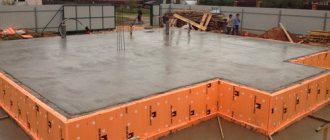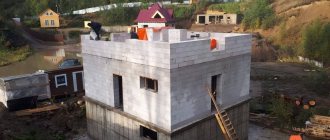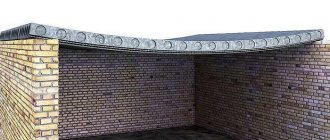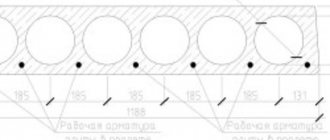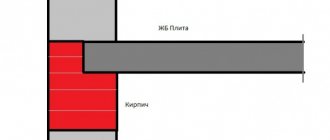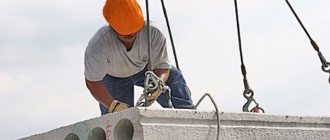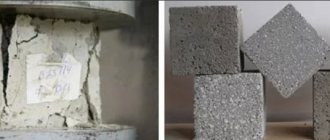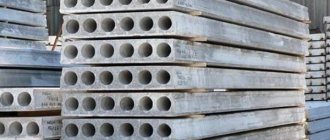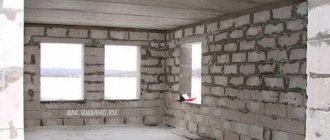Cellular concrete: thermal insulation properties
Thermal insulation materials occupy a special place among construction materials. The trend towards saving thermal energy is growing all over the world. The introduction of new requirements for improving the heat-insulating qualities of external enclosing structures of buildings and structures for various functional purposes requires a constant expansion of the range of heat-insulating materials of improved quality, the creation of new technologies for the production of highly efficient heat-insulating materials for the construction of multi-layer insulation systems.
The main thermal insulation materials widely used today are mineral wool and polystyrene foam, which, despite all their advantages, have obvious disadvantages. Mineral wool destructs over time during use - it shrinks, forming spaces unprotected from heat leakage, and polystyrene foam is a flammable material.
Thermal insulating cellular concrete has a unique combination of physical and technical properties (low thermal conductivity, rigidity, non-flammability, high vapor permeability), which will allow it to be widely used for insulating building envelopes and eliminating the main disadvantages inherent in multi-layer insulation systems based on mineral wool and expanded polystyrene products.
Currently, in the Republic of Belarus, thermal insulation slabs made of cellular autoclaved concrete are produced in accordance with the requirements of STB 1034-96. The main range of thermal insulation products made from cellular concrete are slabs with an average density of 350-400 kg/m3. This limitation is primarily due to the disadvantages of the technology for producing cellular concrete of a homogeneous structure. Improving the heat-shielding properties of cellular concrete is possible by reducing its average density, and the decrease in this indicator should not be accompanied by a significant decrease in strength.
When producing products of low average density, researchers and manufacturers faced such technological problems as dispersion of raw materials during wet grinding, intensification of structure formation processes and stabilization of the mixture during expansion, and reduction of the holding time of products before and during heat treatment.
The fundamental difference between autoclave-hardening cellular concrete technology is the long-term destructive effect of gas bubbles on the process of formation of new formations, as a result of which the hardening process is accompanied by a change in volume. An effective solution to all these problems is facilitated by the introduction of various chemical additives into the cellular concrete mixture.
The only enterprise in the Republic of Belarus that has mastered the production of medium-density D250 boards since 2002 is OJSC Grodno Construction Materials Plant.
Obtaining cellular concrete with an average density of 150-200 kg/m3 and acceptable compressive strength is a complex technological task. In such concrete, 90-98% of the volume is occupied by gas and capillary pores, so the interpore “skeleton” must be strong. To obtain such concrete, it is necessary to use high-quality materials. Thus, already at the stage of forming the mass, it is necessary to ensure a non-shrinking structure (due to a carefully selected composition); at the stage of cutting the mass into products, it is necessary to obtain the required strength of raw concrete, excluding the destruction of concrete in places where it is cut with strings, and to preserve the shape of the mass when transporting it to the autoclave. The minimum required strength of cellular concrete is determined by considerations of ensuring the safety of products during transportation and installation during its production.
Increasing the strength of cellular concrete is possible through directed synthesis in order to increase the content of hydrosilicates and the most durable of them, the tobermorite and xonotlite groups, and reduce defects in the structure of concrete. An increase in the content of hydrosilicates is achieved by involving more silica and lime in the silicate formation reaction and by introducing additives.
UE "NIISM" has developed complex chemical additives for cellular concrete based on salts of fatty acids SPK (TU RB 100122953.312-2002). The SPK additive has been developed in two types - for structural cellular concrete of average density grades D400-700 and for thermal insulation - grades of average density D150-400.
The SPK additive is a solution of saponified abietine resin modified with liquid glass, which contributes to the plastic strengthening of the raw material. The technical characteristics of the additive are given below.
Appearance……….Dark brown liquid Mass fraction of dry substances, %, not less……………….20 Density, g/cm3…………………………1.1-1.2 PH…………………………………….8.5-10
The SPK additive has a stable foaming ability with a multiplicity of 15-20, foam stability (“lifetime” is more than 4 hours).
Sodium abietate, contained in the SPK additive, interacts with Portland cement to form calcium and aluminum resinates, which, unlike stearates or fatty acid salts, are soluble in water, and most importantly, have the adsorbing ability to disperse air in building solutions, that is, create pleasant conditions for air entrainment (up to 15% air by volume). Alkali metal hydrosilicates stabilize the mass of extra-light cellular concrete after maturation and reduce the pre-autoclave curing time.
In the process of research during the development of low-density cellular concrete technology, it was found that to improve the quality of the porous structure of cellular concrete, it is preferable to use gas-foam technology.
Porosization of the mixture using this technology is carried out due to air entrainment and gas formation. This technology should include: aeration of sand sludge in a mill due to the introduction of an additive, aeration of a cellular concrete mixture in a mixer by introducing an additive and porousization of the mixture in a mold as a result of gas formation. Table 1
| Index | Results of tests of samples with the addition of SPK, % of dry matter. | |||
| without additives | 0,15 | 0,3 | 0,5 | |
| Average dry density, kg/m3 | 235 | 178 | 187 | 210 |
| Thermal conductivity in a dry state at a temperature of (298±5)°K, W/(m K) | 0,066 | 0,056 | 0,057 | 0,06 |
| Ultimate compressive strength, MPa | 0,8 | 0,82 | 0,9 | 0,96 |
| Bending strength, MPa | 0,18 | 0,18 | 0,27 | 0,29 |
| Sorption humidity by weight Wc, % at φ=90% (operational humidity for operating conditions “B”, Amendment No. 2 SNB 2.04.01-97) | 4,98 | 4,99 | 4,98 | 5 |
table 2
| Index | Standard for brands | |||||
| 150 | 200 | 250 | 300 | 350 | 400 | |
| Average dry density, kg/m3 | 126-175 | 176-225 | 226-275 | 276-325 | 326-375 | 376-425 |
| Thermal conductivity in a dry state at a temperature of (298±5)°K, W/(m K), no more | 0,055 | 0,06 | 0,07 | 0,08 | 0,09 | 0,11 |
| Ultimate compressive strength, MPa, not less | 0,3 | 0,45 | 0,55 | 0,6 | 0,8 | 1 |
| Bending strength, MPa | 0,08 | 0,09 | 0,1 | 0,15 | 0,2 | 0,3 |
| Release humidity, wt. %, no more | 35 | 35 | 35 | 33 (35) | 29 (35) | 25 (35) |
| Note. The release humidity for heat-insulating slabs based on thin lime and waste from cellular concrete production is given in brackets. | ||||||
As a result of experimental studies, the basic technological requirements were developed, which are as follows.
- In the initial state, the cellular concrete mixture must be sufficiently liquid with a high water-solid ratio (W/S) to provide the best conditions for the formation of a cellular structure. When using mixtures with a lower W/T during the swelling period, the structure breaks down and the formation of slot-like voids and streaks occurs.
- Swelling of the mixture should occur within 6-12 minutes to eliminate the influence of environmental temperature factors.
- Stabilization of the massif after completion of the swelling process should be fixed by accelerating the setting processes and increasing structural strength.
- The process of swelling and stabilization of the cellular concrete mass should provide a structure with a pore diameter of less than 0.8 mm, more preferably 0.5 mm, as the least deformable.
- Due to the action of gravitational forces on the lower layers of raw cellular concrete, stabilization of the macrostructure and elimination of its deformations can be achieved by increasing the elasticity of the walls forming the cells. Thanks to this, the gas that creates the pores will maintain excess pressure in them for a long time, which makes it possible to fix the macrostructure of the material in its original state and eliminate sedimentation of the raw material.
Using the proposed technology, pilot batches of heat-insulating cellular concrete of medium density grade D200 were produced. Technical characteristics of samples from the pilot batch are given in Table. 1.
Based on the results of the research, changes were made to STB 1034-96 “Thermal insulating slabs made of cellular concrete” (implementation date: 01/01/2004), the classification of products was supplemented with average density grades D150, D200. The physical and mechanical properties of heat-insulating slabs made of cellular concrete are given in Table. 2.
Expanding the production and range of products made from low-density heat-insulating cellular concrete requires increasing its physical and mechanical properties. Along with significant technical and economic advantages, which contribute to its widespread use in construction, low-density cellular concrete has a number of disadvantages. This is primarily a low ability to absorb tensile forces, as well as reduced crack resistance, which creates certain problems already at the stage of transporting products.
One of the rational ways to eliminate these shortcomings may be dispersed reinforcement with fiber additives. The most accessible component for dispersed reinforcement is dry waste from asbestos-cement production. As a result of the studies, it was found that the presence of clinker minerals and calcium hydroxide in asbestos-cement waste can determine some of the astringent properties of the waste. These wastes contain asbestos fibers, which exhibit not only reinforcing, but also structure-forming properties. Crushed asbestos cement can be considered as a crystalline seed containing in its composition the nuclei of crystallization of new formations that arose during the hydration of Portland cement.
As a result of preliminary studies, we have established that the introduction of asbestos-cement waste into the composition of a low-density cellular concrete mixture (D150, D200) makes it possible to increase the flexural strength by 2-3 times. It is more expedient to introduce asbestos-cement waste into the cellular concrete mixture at the stage of preparing sand sludge. Combined wet grinding of asbestos-cement waste and sand will reduce the grinding time and ensure safe working conditions.
Similar
Bonding thermal insulation boards to the base
For gluing heat-insulating boards, Bonolit “Formula Heat” polyurethane adhesive is used, supplied in aerosol cans.
4.1.Conditions of work:
| Cylinder/gun temperature | +10⁰C to +30⁰C |
| Application temperature | -100C to +300C |
| Surface temperature | -100C to +300C |
| Minimum relative humidity at +23⁰C | 45% |
4.2. Method of using Bonolit polyurethane adhesive “Heat Formula”.
- Shake the can vigorously for 30 seconds.
- Screw the gun to the cylinder. Always keep the can upside down during use.
- Apply the adhesive to the heat-insulating board in three strips 3 cm wide. Two strips are applied at a distance of 5 cm from the short ends and one strip in the middle of the board.
- Roller volume and application speed are controlled by the pressure applied to the gun trigger. The nozzle of the gun must be kept in the applied glue at a distance of 1 cm from the surface of the block.
- Glue the boards no later than 1 minute after applying the glue (according to the open time parameters of the glue).
- The slabs must be glued as close to the design position as possible. The position of the slabs can be adjusted within 3 minutes after gluing within a range of 0.5 cm, without lifting them from the surface.
- If the slab detaches from the surface during adjustment, it is necessary to remove the glue from the surface of the slab (mechanically after hardening), then reapply the glue and re-glue it.
- To eliminate cold bridges, increase durability and strengthen the structure, it is recommended to apply glue in the seams between the slabs. In this case, the glue is applied in a 2 cm wide strip to the vertical and horizontal ends of the already glued slabs.
- Full load-bearing capacity is achieved after 24 hours.
4.3. Sequence of work:
4.3.1. You should always aim to glue entire insulation boards. The long side of the slabs should be horizontal. To ensure consistent dressing, half slabs are used. It is also allowed to glue locally sections of slabs with a length of at least 150 mm, provided they are installed on a plane, but not at corners, not at the end of the insulated surface, and not near openings.
4.3.2. The first row of thermal insulation boards must be glued against the base profile or mounting rail. If there is a seam between the base profile and the base, it must be filled and puttied with adhesive or other suitable composition.
4.3.3. After the polyurethane glue has hardened, the slabs of the first row must be additionally secured with dowels (see point 5). After this, you can glue the next row of slabs.
4.3.4. Each subsequent row of thermal insulation boards is glued in the direction from bottom to top, observing the ligation (displacement) of the vertical seams in each row, as well as alternate ligation on the external and internal corners of the building. Avoid the formation of cross-shaped (+) seams and seams in the corners of openings.
4.4. When gluing thermal insulation boards, follow these rules:
4.4.1. When marking the cutting line for insulating boards, use a steel ruler and square. Cut the slabs carefully using a saw with a rigid blade.
4.4.2. It is necessary to strictly maintain the flatness of the outer surface of the entire thermal insulation layer. The plane of the glued slab relative to the plane of the already glued adjacent slabs is leveled and controlled by the 2-meter rule.
4.4.3. The ends of adjacent thermal insulation boards must be tightly adjacent to each other. To do this, the ends can be sanded with coarse sandpaper. When seams more than 2 mm wide are formed, they must be filled with polyurethane glue.
4.4.4. The location of vertical seams between heat-insulating boards must be at a distance of at least 100 mm: - from large restored inactive cracks in the base; - from places with different wall thicknesses protruding on the outer surface of the base; - from the boundaries of bases made of different materials.
4.4.5. Existing expansion joints on the base must be preserved. Gluing slabs with overlapping expansion joints is not allowed.
4.5. Preparing the surface of the slabs for subsequent work.
The surface of the heat-insulating boards after the adhesive joint has fully gained strength (no earlier than 24 hours) must be sanded and thoroughly removed from dust. This allows you to eliminate unevenness and increase adhesion with subsequent finishing layers.
Aerated concrete.
Aerated concrete is produced from a concrete mixture, the hardening of which occurs at high temperatures in special ovens (autoclave), therefore the production of aerated concrete blocks is carried out at special manufacturing plants. The density of the blocks can be different (from 350 to 700 kg/m3). Aerated concrete blocks arrive at the construction site in finished form, and the walls are erected by analogy with brickwork.
Currently, many private low-rise buildings in our country are built from cellular concrete, i.e. aerated concrete, foam concrete and gas silicate blocks. And this is not surprising, because cellular concrete was invented as an alternative to traditional brick in order to reduce the cost per square meter of wall. This reduction in cost is achieved primarily due to the lower thermal conductivity of the material. Since thanks to this very factor, the wall turns out to be thinner, lighter and the insulation, if required, is of significantly less thickness than in the case of brickwork.
Cellular concrete blocks are divided by grade: usually from D300 to D1200. The number in the designation means the density of the material in kg/m3. That is, for example, aerated concrete brand D300 has an approximate density of 300 kg/m3. In turn, this density affects other characteristics of the blocks: strength and thermal conductivity. And based on these characteristics, products made from cellular concrete are divided into 3 groups, so that it is more convenient for the average person to decide on the brand in the designs of their home or other structure. Thus, in accordance with GOST 31359-2007, cellular concrete is divided into: heat-insulating, structural-thermal-insulating and heat-insulating (see Table 1)
Table 1. Types of cellular concrete by purpose.
When talking about concrete, many people imagine something very heavy. And not everyone knows that there are different types of concrete mixture and products made from it with a wide range of applications in various fields of construction.
In this article we will talk about several types of lightweight concrete that are used as materials for insulating structures. Let’s figure out how during manufacturing a special structure and low weight are achieved while maintaining strength, albeit not high, and we’ll analyze the reasons for the popularity of such materials.
So, thermal insulating concrete: what is it and how is it used?
